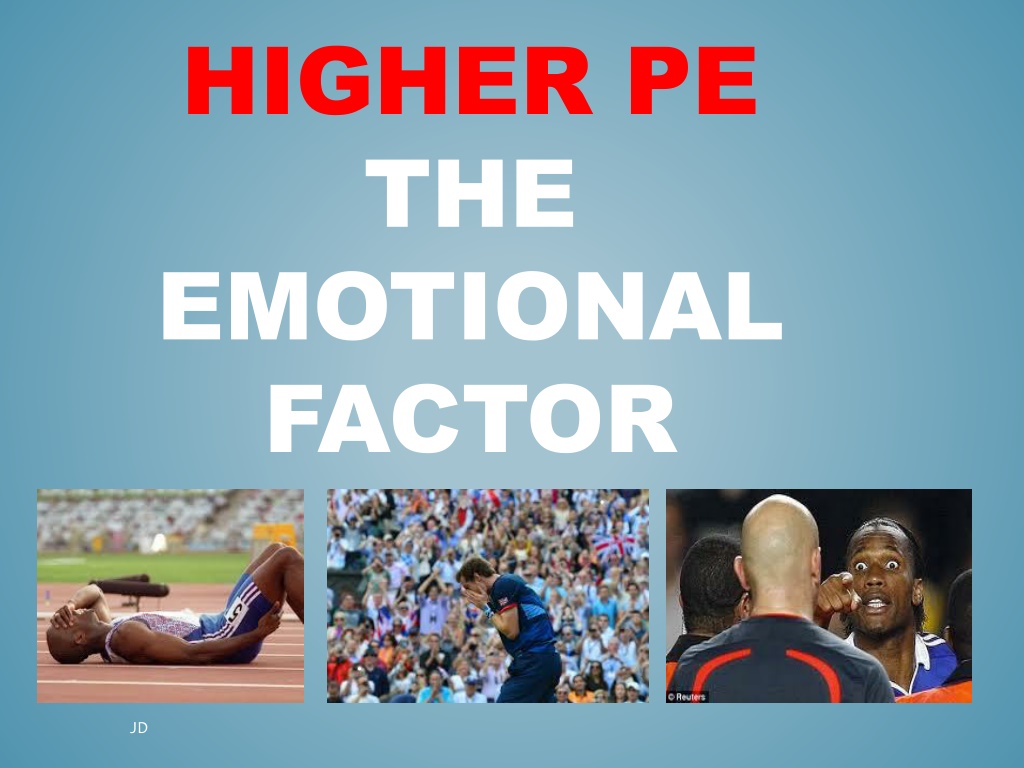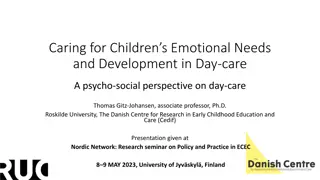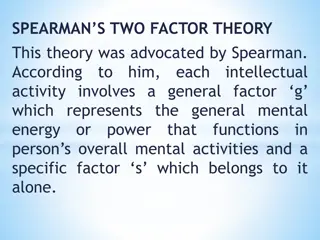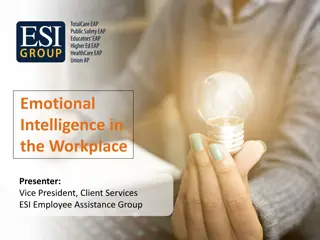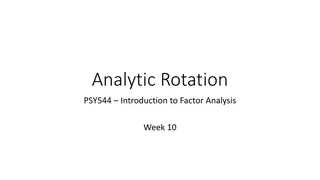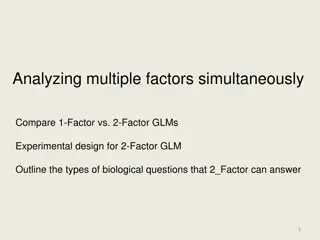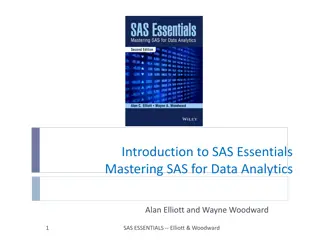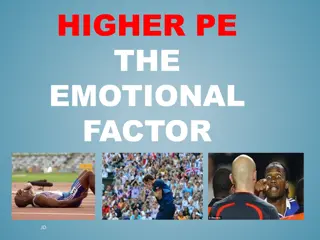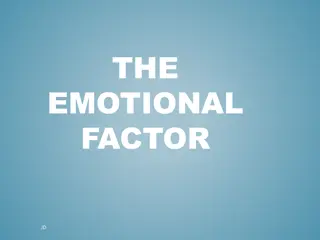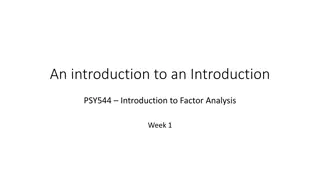Understanding the Emotional Factor in Performance - Impact and Scenarios
The presentation explores how the emotional factor influences performance in sports, detailing aspects like happiness, trust, anger, fear, and surprise. It delves into how these emotions can positively or negatively affect performance, with examples from basketball scenarios provided as illustrations.
Download Presentation

Please find below an Image/Link to download the presentation.
The content on the website is provided AS IS for your information and personal use only. It may not be sold, licensed, or shared on other websites without obtaining consent from the author. Download presentation by click this link. If you encounter any issues during the download, it is possible that the publisher has removed the file from their server.
E N D
Presentation Transcript
HIGHER PE THE EMOTIONAL FACTOR JD
Plagiarism Warning Throughout this power point there are sample answers. Please note that these sample answers are not to be used as your own work they are for reference only. If you fail to comply with this request you will be at risk of failing the course.
THERE ARE FIVE ASPECTS IN THE EMOTIONAL FACTOR These are: Happiness & Sadness Anger Fear Trust Surprise
HOW CAN THE EMOTIONAL FACTOR AFFECT HOW CAN THE EMOTIONAL FACTOR AFFECT PERFORMANCE? PERFORMANCE? Here are some ways in which the following factors may impact performance. Happiness / Sadness May have an impact on confidence, self belief, you may doubt your own ability. You may be more optimistic or pessimistic. Anger Will impact on self control, decision making, clarity of thought. Fear Will impact on decision making, confidence, nerves. Trust This will affect self respect, respect for team mates, confidence I your own ability and others to execute roles/tasks etc. Surprise This will impact on decision making , resilience, confidence. https://www.youtube.com/watch?v=xNY0AAUtH3g
Emotional Factor Task Select three aspects from the Emotional Factor. Describe how two of the aspects you picked had a positive impact during your performance and how one had a negative impact during your performance. Support your answer with examples and scenarios. The same activity must be used throughout however not all scenarios need to come from the same performance. (6)
Task Sample Answer The three aspects from the Emotional factor l will discuss are Happiness, Trust and Anger, l will use Basketball as my sport. Happiness positively affected my performance as scoring an impressive lay up in the opening minute made me feel good about myself and boosted my confidence to attempt the shot again which I did several times scoring 85% of total lay-up s taken. My teammates also congratulated me making me feel happy. This boosted my confidence and made me relax benefitting my awareness and concentration.
Sample Answer Cont. Trust - When playing tough opponents, I feel under pressure to play well and this makes me begin to doubt my ability. However, my coach spoke to me before our last match saying I had done well in training and that I was now one of the strongest players in the team. He then asked me to mark the opponents best player. This was a massive task but it made me feel extra confident, relaxed and secure as I knew my coach had faith in my ability. This paid off as I was able to subdue my opponent, they only scored 8 points in the whole match. My confidence was sky high and my place in the team felt extremely secure as a result of trust.
Sample Answer Cont. Anger affected my decision making and level of arousal, especially when the referee made bad decisions. This led to me not thinking clearly and making simple mistakes such as shooting when I should pass to a team mate in a far better position. This happened on five occasions, which cost our team a potential ten points. I also got angry when one of my team mates didn t pass the ball when I was open for a lay up in the first quarter. This caused disharmony and a negative atmosphere in the team which is not positive. This led to us loosing some cheap baskets.
METHODS OF METHODS OF INVESTIGATING .. INVESTIGATING .. Disciplinary Record Questionnaire / Self Reflection Coach Feedback Profile of Mood States Test (POMS) http://www.brianmac.co.uk/poms.ht m
Emotional Questionnaire Here is an example of an emotional questionnaire for elite level sportspeople: http://www.midss.org/content/ sport-emotion-questionnaire PS, its at bottom of page, word doc.
Disciplinary Record Below is an example of a Basketball disciplinary record. A skilled assessor needs to fill this in as they know what to look for and are a reliable source. Foul Type Game 1 Game 2 Game 3 Technical (unsporting) Types of foul could be related to certain aspects of the Emotional Factor. Personal (types of contact) Flagrant (violent conduct) EG. Flagrant - Anger Shooting (illegal prevention)
Profile of Mood States (POMS) http://www.brianmac.co.uk/poms.h tm POMS - A psychological test designed to measure a person's affective states. These include tension, depression, anger, vigour, fatigue, and confusion. Unlike personality traits, mood states are thought to be temporary and specific to a given situation, although moods can also be measured for recent prolonged periods such as the past several months. POMS is a popular research tool among sport psychologists. Take the test yourself and then compare your scores to the averages in the norms table to see which category you are closest too.
Task Describe one method you used to investigate the Emotional factor, explain how you carried out this investigation in detail. (4) Explain and justify why you chose this method of investigation (4)
Task break down Question 1 Name the method you used. Explain how you went about executing this method, tell us what you did, when you did it & how you did it etc. (2) Provide evidence from the method to prove you actually did it, such as: questions from the questionnaire, things your coach would assess you on, POMS questions / test criteria. Diagrams are allowed. (2) Question 2 Ease of use? Reliable source? Can be easily re tested after training? Shows strengths / weaknesses? Instant feedback? Gives motivation to improve?
Development Approaches Team Talks (coaches and players) Team Meetings (players only) Self Talk The 3 R s, Recognise, Regroup & Refocus. Mental Rehearsal, Rituals & Routines. Conflict Management techniques Rewards , prizes, bonus s (Internal & External).
Team Talks (C&Ps) (Normally led by Coach, Manager) Pre game Re cap on training, game, targets of last week etc. Focus on opponents S&W s Motivation Tactics https://www.youtube.com/watch?v=cGQjam2ocqo Post Game (24 hrs) Post match analysis, positive & negative. C & P s share their opinions on ways forward. New targets, plans made.
Team Meetings (The things coaches don t hear!) Normally done by Captain, Senior players or you!! Pre game Motivation Recap tactics Target setting Mid game Organisation Tactics Motivation Post game Praising good performance Re setting targets Motivation
Self Talk the 3 Rs Recognise Regroup Re focus These three aspects can be done during training drills for each sport. They would be most effective during pressurised situations / drills or conditioned / training games or during real matches.
Recognise Where am l going wrong? How is it happening? What am I doing differently to before? Elite performers may ask questions such as these when in times of difficulty. Once they have figured out their problem they then can Re Group Fix errors by Positive thoughts of previous performances Visualising better performance Using motivational phrases that helped before Re Focus Calm down the situation Remember everything that has been done in training Clear mind, ready to achieve
Conflict Management Conflict Conflict exists when one person has a need of another and that need is not being met. From the pictures above you can see how conflict in sports happens regularly. Have you ever been in conflict with a team mate?
How to Resolve Conflict A neutral party is brought in to mediate (police the discussion) Rules for the discussion are made Both parties must agree to be open, honest and listen to the other person without interruption. Both parties get time to express their views, if they are providing examples they must be based on facts. The mediator then aims to find common ground between the parties. you both want to win the league, don t you Mediator then will encourage parties to make concessions to understand the opposing parties view point and hopefully comes to an agreement between both parties.
Mental Rehearsal, Rituals & Routines. https://www.youtube.com/watch?v=RCA6I13aczM Badminton Stand in the same spot when serving. Basketball Bounce the ball 3 times before a free throw. Football Measure three steps back from the ball before a free kick. Volleyball Align the valve on the ball to face your body before serve. These rituals can aid, Trust & Happiness. They will also conquer Fear and Surprise as you will be comfortable in your environment. However any variation of these could lead to Anger.
Development Needs Task (a)Select one aspect from the Emotional Factor which effects you greatly when performing in your activity. Choose an appropriate development approach and outline how you will go about using this approach to overcome your identified emotional weakness. (4) (b)Justify your decision to use the selected development approach in part (a) (3)
(a) Volleyball Serve Emotional Factor Weakness Trust Development Method Mental Rehearsal, Rituals & Routines Recently doubting my ability to serve well, 7/10 hit net last game Subbed when my turn to serve! Spend time after training on my own Create a routine of, check left foot just in front of right, bounce ball 3 times to prepare mind ( what part of ball to hit, which part of hand to hit with, target). Central hand grip, to left hand under, align valve to front, throw to shoulder height, curve right hand, hit centre of the ball. Do this in a non pressurised environment Get comfortable, feel skill is at autonomous stage again. Then record, how many out of 10 land in court etc. Before serve in game run through routine slowly, focussing on what my mind is telling me.
(b) Justification - Approach will allow me to Regain confidence by practising under no pressure or time constraint. Groove skill into mind, get back to autonomous stage, restore faith in ability. Routine will become second nature which can be performed under pressure. Mentally will feel confident, training scores to prove I can perform the serve to a high standard. Method can be overloaded to increase pressure, resulting in team mates witnessing better performance and they will have faith restored.
Monitoring Emotional Development Training Diary - record thoughts and feelings Disciplinary record s, compare and contrast Questionnaire s, compare and contrast Coach feedback
Revision Q 1 Explain how the Emotional factor impacted on your performance, use any sport of your choice (4) Q 2 Discuss one method that you used to investigate within the Emotional Factor. Describe how you carried out this method. (4) Q 3 Justify your decision to use this method of investigation (4) Q 4 Review the information you gathered, making reference to your performance strengths and development needs. (4) Q 5 In detail describe a development approach you used to improve you development need(s), explain a training session you did using this method and how you would progress it. (4)
